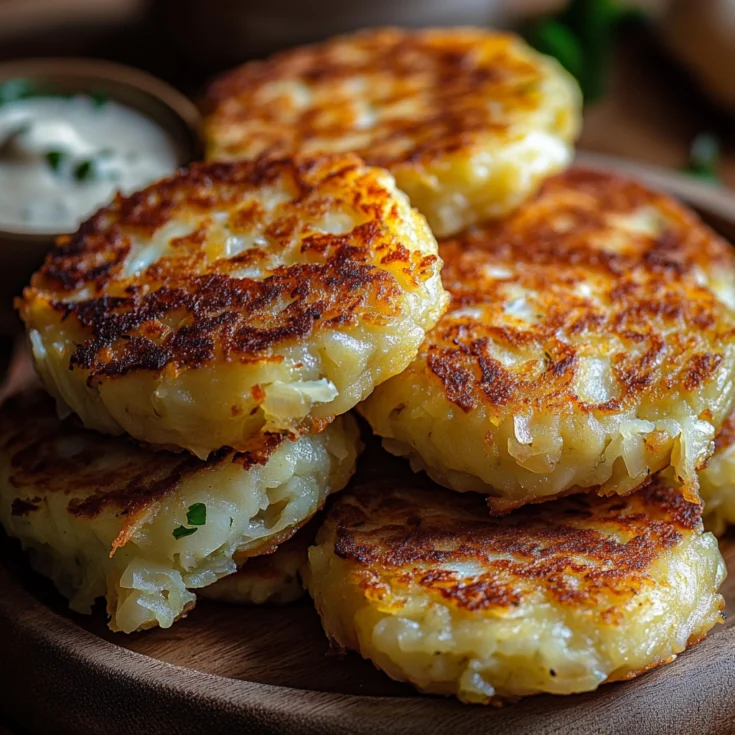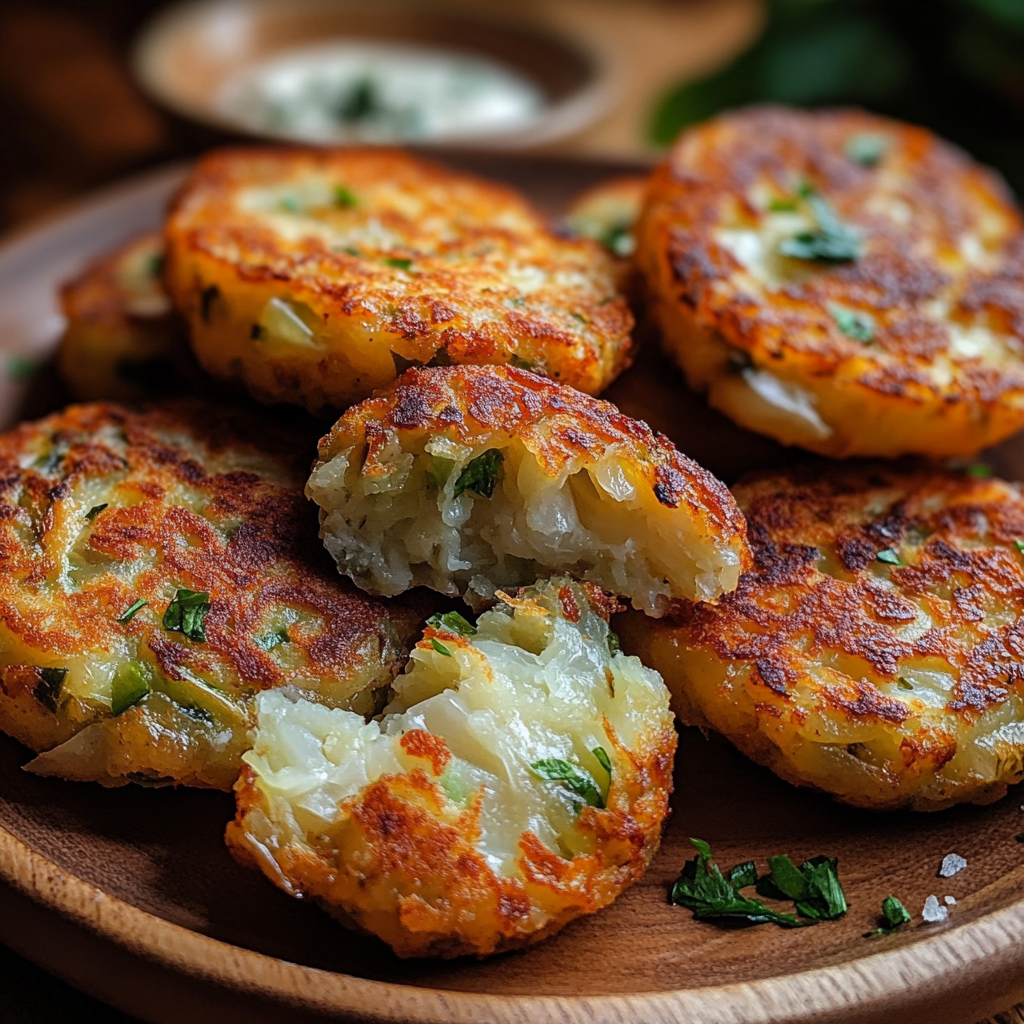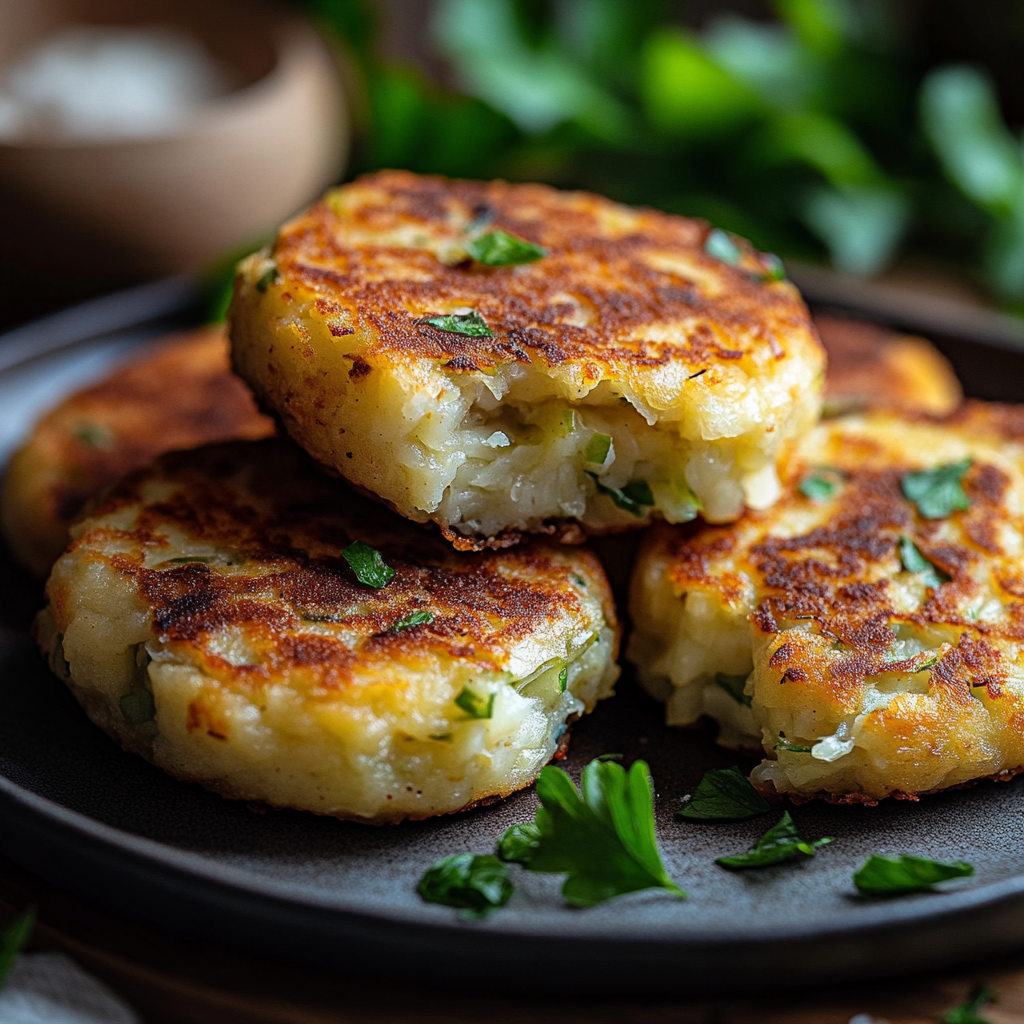Introduction to Cabbage Patties
What Are Cabbage Patties?
Cabbage patties are delicious, savory fritters made primarily from shredded cabbage, mixed with spices, herbs, and binding agents like flour or eggs. These patties are pan-fried, baked, or air-fried to achieve a crispy exterior and tender interior. Originating from various cuisines worldwide, cabbage patties have become a staple in vegetarian and health-conscious diets.
Historically, cabbage patties have roots in Eastern European and Asian cooking, where cabbage is a widely available and affordable vegetable. Over time, they’ve gained global popularity due to their simplicity, versatility, and nutritional value.
Why Are Cabbage Patties Popular?
Cabbage patties are celebrated for their health benefits and adaptability in the kitchen. Cabbage, the star ingredient, is packed with vitamins C and K, fiber, and antioxidants, making it a powerhouse of nutrition. These patties are not only low in calories but also suitable for various dietary preferences, including vegan, gluten-free, and low-carb diets.
Their versatility shines in how they can be customized with additional vegetables, spices, or even cheese. Whether served as a snack, side dish, or main course, cabbage patties offer a satisfying crunch and flavor that appeals to all ages.
Purpose of the Article
This article dives deep into the world of cabbage patties, exploring their health benefits, sharing step-by-step recipes, and offering tips to perfect your patty-making skills. Whether you’re a seasoned cook or a beginner, you’ll find everything you need to create delicious, crispy cabbage patties at home.
Health Benefits of Cabbage Patties
Nutritional Profile of Cabbage
Cabbage is a nutrient-dense vegetable that offers a wide range of vitamins and minerals essential for overall health. It’s rich in vitamin C, which supports immune function, and vitamin K, crucial for bone health and blood clotting. Additionally, cabbage provides folate, manganese, and vitamin B6, all of which play vital roles in energy production and cellular health.
One of the standout features of cabbage is its low-calorie content, making it an excellent choice for weight management. A single cup of shredded cabbage contains only about 22 calories. Moreover, cabbage is high in dietary fiber, which aids digestion, promotes satiety, and helps regulate blood sugar levels.
Health Benefits of Cabbage Patties
Cabbage patties aren’t just tasty—they’re also incredibly good for you. Here’s why:
- Supports Digestion and Gut Health
The high fiber content in cabbage promotes healthy digestion by preventing constipation and supporting a balanced gut microbiome. This makes cabbage patties a gut-friendly option for those looking to improve their digestive health. - Boosts Immunity with Antioxidants
Cabbage is loaded with antioxidants, including vitamin C and polyphenols, which help combat oxidative stress and strengthen the immune system. Regular consumption of cabbage patties can contribute to better overall immunity. - Promotes Heart Health
The fiber, potassium, and antioxidants in cabbage work together to support cardiovascular health. Fiber helps lower cholesterol levels, while potassium regulates blood pressure, reducing the risk of heart disease.
Why Cabbage Patties Are a Healthy Choice
When compared to other patty options, cabbage patties stand out as a healthier alternative. For instance, meat-based patties are often high in saturated fats and calories, while potato patties can be starchy and calorie-dense. Cabbage patties, on the other hand, are light, nutrient-packed, and low in calories.
Cabbage patties are also incredibly versatile, catering to various dietary needs. They’re naturally vegan when made without eggs, gluten-free when using gluten-free flour, and low-carb when prepared with minimal binding agents. This makes them an inclusive option for people with specific dietary preferences or restrictions.
Ingredients and Preparation
Essential Ingredients for Cabbage Patties
Cabbage patties are a versatile dish that can be customized based on dietary preferences and flavor profiles. Here’s a breakdown of the essential ingredients:
- Cabbage
- Types of Cabbage: Green cabbage is the most commonly used, but red cabbage or savoy cabbage can add color and texture.
- Quantity: Typically, 2-3 cups of shredded cabbage are needed for a standard recipe serving 4-6 patties.
- Binding Agents
- Eggs: A traditional binding agent that helps hold the patties together.
- Flour or Breadcrumbs: These add structure and absorb excess moisture.
- Vegan Alternatives: Flaxseed meal mixed with water, chia seeds, or mashed potatoes can replace eggs for a vegan-friendly option.
- Seasonings
- Basic Seasonings: Salt, black pepper, and garlic powder are staples.
- Flavor Enhancers: Paprika, cumin, or chili powder can add depth.
- Fresh Herbs: Parsley, dill, or cilantro provide a fresh, aromatic touch.
- Optional Add-Ins
- Vegetables: Grated carrots, finely chopped onions, or mashed potatoes can enhance texture and flavor.
- Cheese: Parmesan, cheddar, or feta can add richness (optional for non-vegan versions).
- Protein: Crumbled tofu or cooked lentils can make the patties more filling.
Tools and Equipment Needed
To prepare cabbage patties efficiently, you’ll need the following tools:
- Mixing Bowls: For combining ingredients.
- Box Grater or Food Processor: To shred the cabbage finely.
- Frying Pan or Skillet: For pan-frying the patties.
- Baking Tray or Air Fryer: For a healthier, oil-free cooking method.
- Spatula: To flip the patties without breaking them.
- Paper Towels or Clean Kitchen Towel: For removing excess moisture from the cabbage.
Preparing the Cabbage
Proper preparation of the cabbage is crucial to achieving the right texture for your patties. Follow these steps:
- Shredding or Grating the Cabbage
- Use a box grater or food processor to shred the cabbage finely. This ensures even cooking and a cohesive mixture.
- If using a knife, slice the cabbage thinly and then chop it into small pieces.
- Removing Excess Moisture
- Salting Method: Sprinkle salt over the shredded cabbage and let it sit for 10-15 minutes. The salt draws out moisture, preventing soggy patties.
- Squeezing Technique: After salting, place the cabbage in a clean kitchen towel or cheesecloth and squeeze out as much liquid as possible.
- Alternative Method: If you’re short on time, pat the shredded cabbage dry with paper towels.
- Mixing the Ingredients
- Combine the shredded cabbage with your chosen binding agents, seasonings, and optional add-ins in a large mixing bowl.
- Mix thoroughly until the mixture holds together when pressed. If it’s too dry, add a splash of water or plant-based milk. If it’s too wet, add more flour or breadcrumbs.
Step-by-Step Cooking Instructions
Classic Cabbage Patties Recipe
Cabbage patties are simple to make but require attention to detail to ensure they turn out crispy on the outside and tender on the inside. Follow these steps for perfect results:
Step 1: Preparing the Cabbage Mixture
- Shred the Cabbage: Use a box grater or food processor to finely shred 2-3 cups of cabbage.
- Remove Moisture: Sprinkle salt over the shredded cabbage and let it sit for 10-15 minutes. Squeeze out the excess liquid using a clean kitchen towel or cheesecloth.
- Prepare Add-Ins: If using onions, carrots, or other vegetables, grate or finely chop them.
Step 2: Mixing Ingredients Thoroughly
- Combine Ingredients: In a large mixing bowl, add the shredded cabbage, 2 beaten eggs (or vegan alternatives like flaxseed meal), ½ cup flour or breadcrumbs, and your chosen seasonings (e.g., 1 tsp garlic powder, ½ tsp paprika, salt, and pepper).
- Add Optional Ingredients: Mix in grated carrots, chopped onions, or herbs if desired.
- Check Consistency: The mixture should hold together when pressed. If it’s too dry, add a splash of water or plant-based milk. If it’s too wet, add more flour or breadcrumbs.
Step 3: Shaping the Patties
- Form Patties: Take a small handful of the mixture (about ¼ cup) and shape it into a round patty, approximately ½-inch thick.
- Flatten Gently: Press the patties gently to ensure even cooking. Avoid over-packing, as this can make them dense.
- Set Aside: Place the shaped patties on a plate or tray lined with parchment paper.
Step 4: Cooking Methods
- Pan-Frying:
- Heat 2-3 tablespoons of oil in a skillet over medium heat.
- Carefully place the patties in the pan, leaving space between them.
- Cook for 3-4 minutes on each side, or until golden brown and crispy.
- Drain on paper towels to remove excess oil.
- Baking:
- Preheat the oven to 375°F (190°C).
- Place the patties on a baking sheet lined with parchment paper.
- Lightly brush or spray the patties with oil.
- Bake for 20-25 minutes, flipping halfway through, until golden and crispy.
- Air-Frying:
- Preheat the air fryer to 375°F (190°C).
- Lightly spray the patties with oil.
- Cook for 10-12 minutes, flipping halfway through, until crispy and cooked through.
Tips for Perfect Cabbage Patties
- Achieving the Right Consistency:
- Ensure the cabbage is well-drained to prevent soggy patties.
- Use enough binding agents (eggs, flour, or breadcrumbs) to hold the mixture together.
- Avoiding Common Mistakes:
- Don’t overcrowd the pan when frying, as this can lower the oil temperature and make the patties greasy.
- Avoid over-mixing the ingredients, as this can make the patties dense.
Serving Suggestions
- Dipping Sauces:
- Yogurt-Based: Mix Greek yogurt with lemon juice, garlic, and dill.
- Spicy: Combine mayonnaise with sriracha or hot sauce.
- Sweet: Serve with sweet chili sauce or honey mustard.
- Side Dishes:
- Salads: Pair with a fresh green salad or coleslaw.
- Soups: Serve alongside a warm bowl of tomato soup or vegetable broth.
- Roasted Vegetables: Complement with roasted carrots, potatoes, or zucchini.
FAQs About Cabbage Patties
What Are Cabbage Patties Made Of?
Cabbage patties are primarily made from shredded cabbage, combined with binding agents like flour or eggs, and flavored with spices, herbs, and aromatics. Optional add-ins include grated vegetables, cheese, or plant-based alternatives for extra texture and taste.
Are Cabbage Patties Healthy?
Yes, cabbage patties are a nutritious choice. Cabbage is low in calories but high in fiber, vitamins C and K, and antioxidants. When prepared with minimal oil and wholesome ingredients, these patties are a healthy option for vegans, gluten-free diets, and anyone looking to eat lighter.
Can I Freeze Cabbage Patties?
Absolutely! Cabbage patties freeze well. For uncooked patties, freeze them on a baking sheet before transferring to a freezer-safe bag. Cooked patties can be frozen in layers separated by parchment paper. Reheat directly from frozen for a quick, crispy meal.
How Do I Prevent My Cabbage Patties from Falling Apart?
To keep patties intact:
- Squeeze excess moisture from the cabbage.
- Use enough binding agents (flour, eggs, or flaxseed meal).
- Let the mixture rest for 10 minutes before shaping.
- Press firmly when forming patties and cook on medium heat.
What Are the Best Dips for Cabbage Patties?
Cabbage patties pair well with a variety of dips:
- Creamy: Tzatziki, garlic aioli, or ranch dressing.
- Spicy: Sriracha mayo or chipotle sauce.
- Tangy: Lemon tahini or yogurt-based dips.
- Fresh: Salsa verde or mango chutney. Yield: 8 patties
Crispy Cabbage Patties

A delicious and crispy snack or side dish made with shredded cabbage, spices, and simple ingredients. Perfect for any meal!
Ingredients
- 4 cups shredded cabbage
- 1/2 cup grated carrots
- 1/4 cup chopped onions
- 2 cloves garlic, minced
- 1/4 cup chickpea flour (or all-purpose flour)
- 1 tsp cumin powder
- 1/2 tsp paprika
- Salt and pepper to taste
- 2 tbsp olive oil (for cooking)
Instructions
- Shred the cabbage and sprinkle with salt. Let it sit for 10 minutes, then squeeze out excess moisture.
- In a bowl, mix cabbage, carrots, onions, garlic, flour, and spices.
- Form the mixture into 8 small patties.
- Heat olive oil in a pan over medium heat.
- Cook patties for 3-4 minutes on each side until golden brown.
- Serve hot with your favorite dipping sauce.
Notes
- For a vegan version, replace chickpea flour with flaxseed meal.
- Patties can be baked at 375°F (190°C) for 20 minutes for a healthier option.
- Store leftovers in an airtight container for up to 3 days.




